About the Object
| Name: | Arp 107 | |
|---|---|---|
| Distance: |
465 million light years | |
| Constellation: | Leo Minor | |
| Category: | Galaxies MIRI | |
Coordinates
| Position (RA): | 10 52 15.67 |
|---|---|
| Position (Dec): | 30° 3' 43.65" |
| Field of view: | 2.39 x 2.51 arcminutes |
| Orientation: | North is 52.5° left of vertical |
Colours & filters
| Band | Wavelength | Telescope |
|---|---|---|
|
Infrared
PAH | 7.7 μm | James Webb Space Telescope MIRI |
|
Infrared
Silicate | 10 μm | James Webb Space Telescope MIRI |
| Infrared | 15 μm | James Webb Space Telescope MIRI |
Arp 107 MIRI image
This image of Arp 107, obtained by Webb’s MIRI (Mid-InfraRed Instrument), reveals the supermassive black hole that lies in the centre of the large spiral galaxy to the right, as evidenced by the small, bright central ‘core’. This bright core, where the black hole is pulling much of the dust into lanes, also features Webb’s characteristic diffraction spikes, caused by the light that it emits interacting with the structure of the telescope itself.
Perhaps the defining feature of the region, which MIRI reveals, are the millions of young stars that are forming, highlighted in blue. These stars are surrounded by dusty silicates and soot-like molecules known as polycyclic aromatic hydrocarbons. The small elliptical galaxy to the left, which has already completed much of its star formation, is composed of many of these organic molecules.
[Image description: A pair of interacting galaxies. The larger of the two galaxies is slightly right of centre, and is composed of a bright, white centre and a ring of blue, gaseous filaments. The centre of this galaxy shows Webb’s eight-pronged diffraction pattern. There are three filaments of gas and dust moving from the ring toward the centre. At the top left of the ring is a noticeable gap, bordered by two large, blue pockets of dust and gas. The smaller galaxy is made of hazy, light blue gas and dust. Many red, green, blue, and yellow galaxies are spread throughout, with some being hazier in composition and others having more defined spiral patterns.]
Credit:NASA, ESA, CSA, STScI
About the Image
| Id: | weic2423b | |
|---|---|---|
| Type: | Observation | |
| Release date: | 18 September 2024, 16:00 | |
| Related releases: | weic2423 | |
| Size: | 1291 x 1356 px | |




